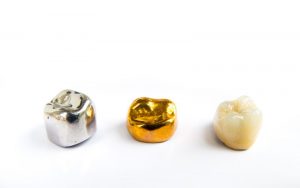Dental Crowns in Warrensburg And Oak Grove, MO

An Easy Way To Restore Your Smile
When a tooth becomes weakened to the point that it can’t safely hold a dental filling, or if a tooth is cracked, chipped, or fractured, a dental crown can return its strength and appearance. Our Missouri dentists may recommend these effective restorations to help restore function and reinforce the strength of your afflicted tooth. The crown saves the tooth, eliminating the need for potential extraction and replacement with a dental implant or bridge.
If you’re looking to restore damaged teeth, the experts at Ridgeview Family Dental can help. We have convenient offices in Warrensburg and Oak Grove, MO and we’re proud to serve patients in Grain Valley, Odessa, Bates City, and the surrounding Missouri areas.
What Is A Dental Crown?
As the name suggests, a dental crown fits over the entire area of the tooth above the gum line, restoring its original size and shape, and more importantly, giving it strength. While inlays and onlays cover the chewing surface of the tooth and fillings fill in the empty interior space of the tooth, crowns completely cover every visible part of the tooth.
Crowns are single piece prosthetics that once placed and cemented onto the underlying tooth. Crowns are very strong and can withstand the chewing and biting forces that the damaged tooth wasn’t able to do.
When teeth have large amounts of decay or deep cracks, they’re in danger of needing extraction. By placing a crown over a weak tooth, it will have full strength once again. Depending on the health of the underlying tooth, crowns can last for decades.
When Would You Need A Dental Crown?
There are two reasons for crowns. First, they’re tooth savers. When the natural tooth suffers from serious damage, such as a deep crack, it’s in danger of needing extraction. If left alone, the damaged tooth will likely break, eliminating the option for crowning it. The same is true if a tooth has a previous filling and then develops new decay. Removing more of the natural tooth will make the tooth very weak. An inlay or onlay could work, but the sure bet is to place a dental crown.
The second use for crowns is to serve as anchors for dental bridges. Bridges are used to fill a gap of one or more missing teeth. Crowns are placed on the healthy teeth on each side of the gap, with artificial teeth (also called crowns but not hollow) attached to gum-colored acrylic resin over metal to replace the missing teeth. The bridge is a single piece and the crowns are cemented permanently onto the healthy teeth.
Dental Crowns Patient Review
“I found the staff and Dentist to be quite friendly and very informative. I left confident that my best interest was their priority. This is the beginning of a lasting and trustworthy relationship. Every person there was cheerful and helpful. All my questions were answered. Thank you so much for your personal aspect as well. I very much appreciate that you specifically indicated that the choice was mine to have two crowns placed. There was no pressure. This is important to me. I am very grateful to have found this group of wonderful dental health providers.”
Rown L. -2/2018
How Dental Crowns Help You Achieve The Perfect Smile
Depending on the type of treatment you have received from one of our dentists, a crown may be necessary to:
- Have your tooth restored to its original size and shape
- Supply additional support for the treated tooth
- Get a complete “makeover” on the affected tooth
- Allow protection for an already weak tooth
Although porcelain crowns certainly can improve the look of a tooth or multiple teeth, it’s recommended only in conjunction with prior repair of the tooth — not simply for cosmetic dentistry purposes.
Types Of Dental Crowns
You may heard crowns referred to as “caps”, particularly by older people. This is because most crowns up until about 20 years ago were made from gold alloy. This made them very visible when the person opened his or her mouth. It looked as if your tooth was wearing a gold cap over it. With advancements in dentistry, crowns can now be made from a variety of materials.
Dental crowns can be placed in just two visits and your expert dentist, Dr. Young or Dr. Kingslover, will talk with you about your options for the type of crown that would fit your situation. This will involve a mix of considering the strength necessary in the area and your cosmetic preferences (i.e. porcelain versus metal).
Today, most crowns are made from porcelain, but there are four types of crowns:
Ridgeview Family Dental Testimonial
“I’ve always had a fear of Dentists – actually not the Dentists themselves but the pain they inflict.”
“That is until I visited Dr. Young’s office.”
“I was so impressed with that first visit that I changed my insurance policy just so I could use them. Because during that first visit, while I was in the examination chair being told that my insurance wasn’t accepted there, Dr. Young continued to consult with me on the problem and potential solutions, even though he wasn’t getting paid for that visit.”
“Their Customer Service got me to be a Customer and their service has and will keep me as a Customer.”
“I only wish I had them as my Dentists years ago. Anyone that has had a bad experience with a Dentist needs to visit Dr. Young and his amazing staff. You will be a convert as well.”
“Thank you for my pain-free smile!!”
Dental Crown Procedure
During your first visit at Ridgeview Family Dental, in preparation for a dental crown, your dentist may take a few X-rays using our advanced dental technology to check the roots of the tooth receiving the crown and surrounding bone.
The tooth receiving the crown is filed down along the chewing surface and sides to make room for the restoration. The amount of the tooth removed depends on the type of crown used. If, on the other hand, a large area of the tooth is missing (due to decay or damage), your dentist will use filling material to “build up” the tooth to support the crown.
After reshaping the tooth, your dentist will make an impression of the tooth to receive the crown. While the crown is getting created, your dentist will make a temporary crown to cover and protect the prepared tooth. Temporary crowns are usually made of acrylic and are held in place using a temporary cement.
For your second visit, your dentist will remove the temporary restoration and check the fit and color of the permanent crown. If everything is acceptable and the patient is comfortable with the crown, a local anesthetic will be used to numb the tooth and the new crown is permanently cemented in place.
Frequently Asked Questions
The longevity of your crown will be determined by the health of the underlying tooth. Take care of that tooth and your crown can last for decades. Otherwise, crowns don’t require any special care, just attentive brushing and flossing every day.
Getting a crown is usually not painful at all. Shaving down the natural tooth doesn’t go deep enough to bother the tooth nerves. Of course, removing decay or addressing other damage in the natural tooth needs to be done first before placing a crown on the tooth. That could involve some minor pain. But preparing the tooth for the crown and placing the crown is painless.
Yes! Dental crown placements are extremely low-risk procedures. Remember, all that’s being done is shaving down the natural tooth to make room for the crown, and then placing the crown onto the tooth. Anesthesia isn’t necessary, so there isn’t a risk of a reaction. There are no incisions. Dental crowns are safe and effective dental procedure.
Typically dental crowns last for about 15 years or more with proper care. The life span of a crown depends on the amount of “wear and tear” the crown is exposed to and the overall personal mouth habits (teeth grinding, nail biting, etc.) and the oral hygiene of the patient.
Schedule a Consultation Ridgeview Family Dental
Broken or decayed teeth can put you health at risk and impact the aesthetic of your smile. Instead of hiding your teeth away, we would love to discuss your options for an effective, natural-looking dental crown.
We proudly serve Grain Valley, Odessa, Bates City, and the surrounding areas thanks to our convenient locations in Warrensburg and Oak Grove, MO. If you’d like to know more about dental crowns or your ready to schedule consultation with one of our expert dentists, contact our office at or fill out the form below.








